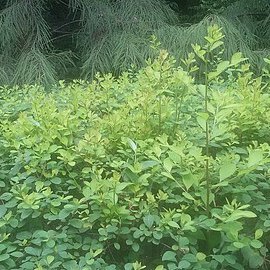Erect shrubs or treelets, usually 2-5(-12) m tall, monoecious or dioecious; branches slender and elongate, "whip-like," often overhanging, pubescent when young, glabrescent, older branches with some spines. Stipules ovate to linear-lanceolate, 2-7 mm, usually caducous, pubescent; petiole 3-5.5 mm, pubescent; leaf blade elliptic, lanceolate-elliptic, or obovate-elliptic, 3-9(-14) × 1.5-5(-6) cm, (thinly) papery, abaxially light greenish and usually pubescent, adaxially scabrous, base obtuse, rarely broadly cuneate or rounded, apex acute to obtuse; lateral veins 7-12(-15) pairs. Flowers axillary, yellow-green, up to 10(-20)-fascicled, sessile. Male flowers: sepals triangular, 0.8-1.2 × 0.5-1 mm; petals spatulate or obovate, entire or 3-5-toothed, ca. 1 × 0.8 mm; disk shallowly cup-shaped, 1-1.2 mm in diam.; staminal column ca. 0.7 mm; free filaments ca. 0.5 mm; rudimentary ovary conical. Female flowers usually 3-5-fascicled, subsessile; sepals triangular, 1-1.5 × 0.8-1.2 mm, glabrous to pubescent outside; petals as in male, shorter than sepals; disk pulvinate and urceolate, enclosing ovary for ca. 0.6 mm; ovary globose to ovoid, ca. 1 mm in diam.; styles 2, bipartite, lobes linear. Drupes subglobose, 4-7 × ca. 5 mm, 2-celled. Seeds semiovoid, 3-4 × 2-3 mm, brown-red, rugulate, adaxial surface compressed with longitudinal groove, abaxial surface slightly elevated with longitudinal stripes. Fl. and fr. almost throughout year.
More
Shrub to 4 m high. Stipules linear to linear-lanceolate, 2–3.5 mm long, entire. Leaves: petiole 2.5–4 mm long, rounded on top, brownish; lamina elliptic, oblong, oblanceolate, obovate or orbicular, up to 90 mm long and 55 mm wide, base cuneate to rounded, margin entire, sinuate, with distinct marginal vein, tip acute, obtuse or rounded, venation comprising 9–11 lateral veins per side of midrib and reticulate interlaterals, lower surface with scattered to dense non-velutinous indumentum mainly on veins. Sepals lanceolate to ovate, 0.8–1.6 mm long, 0.7–0.8 mm wide, glabrous. Petals spathulate to obovate with the tip crenate, 0.5–0.8 mm long, 0.4–0.5 mm wide. Disc 1–1.2 mm diam. Fruits 1–10 per glomerule; each fruit 2-seeded, globose to ellipsoid, 3.5–5 mm long, 2–6 mm wide, red-brown when immature, black when fully ripe.
A small spindly shrub 2-3 m high. They can grow to 10 m high and be 2-3 m across. The young shoots are covered with short tangled hairs. The tree loses many of its leaves during the year. The bark is tight and smooth and mottled creamy-grey. The leaves are small and not shiny. The leaf shape and size varies considerably even on one plant. Leaves are 3.5-8.5 cm long by 1-5 cm wide. They are light green above and paler underneath. The leaf tip can be rounded or pointed. The veins are easily seen. The flowers are small and green. They can occur on their own or in small groups. It produces small berry like fruit along the twigs. The fruit are green when young and turn black when ripe. They are 0.4-0.6 cm across. These enclose one or two hard shelled seeds.
Deciduous to evergreen forests, primary to secondary vegetation; reported from sandy or loamy soil, limestone, and over granite bedrocks at elevations up to 1,000 metres. It is rather common on waste land and in secondary forests.
More
A tropical plant. It grows in open savannah grassland and in secondary regrowth. It grows in tropical lowland areas below about 450 m altitude. The plant occurs in countries from India to Australia. In Yunnan.
Grows in open woodland and either along the margins of, or in, deciduous vinethickets on a variety of substrates.


